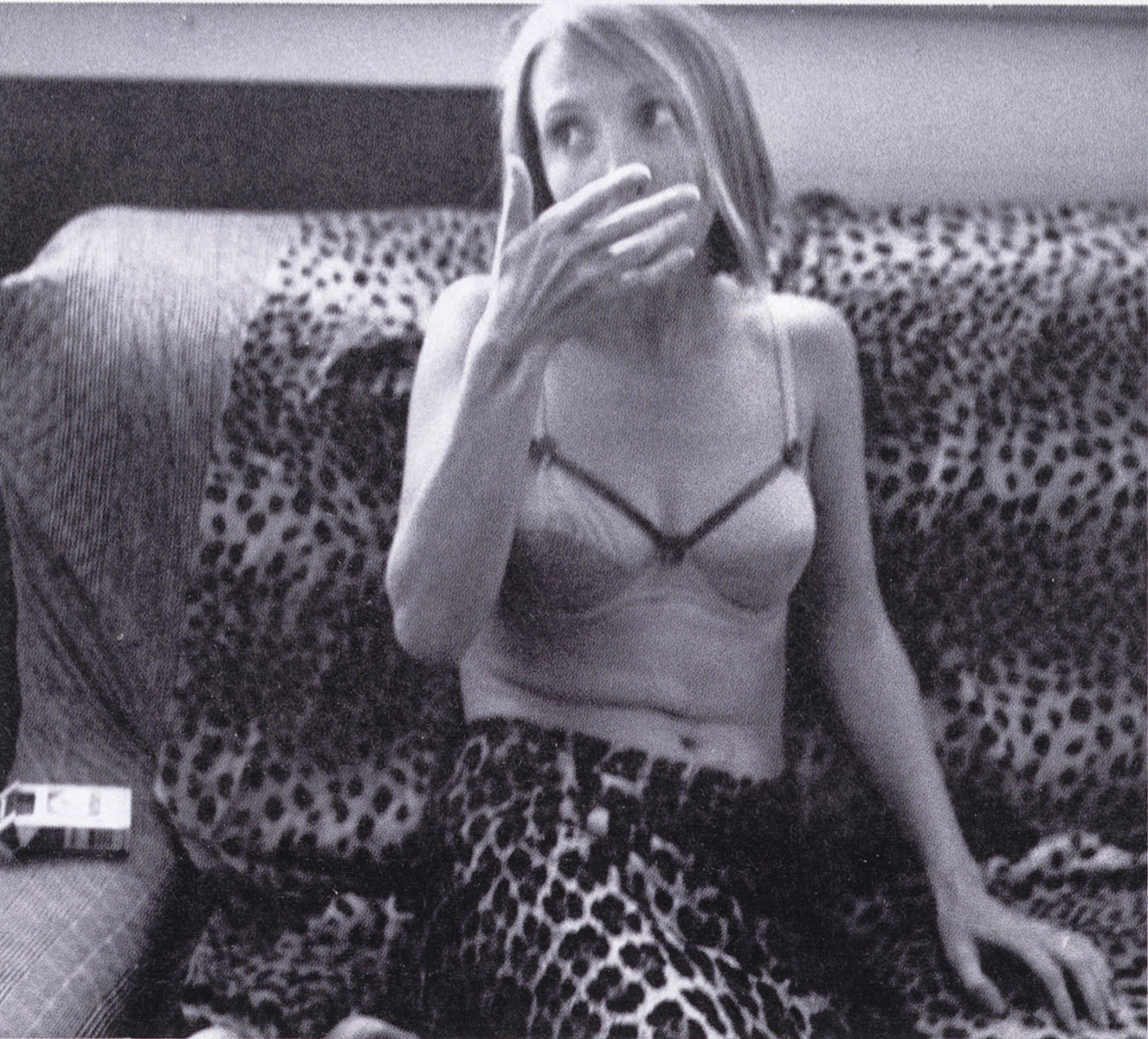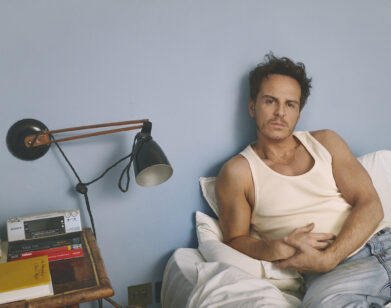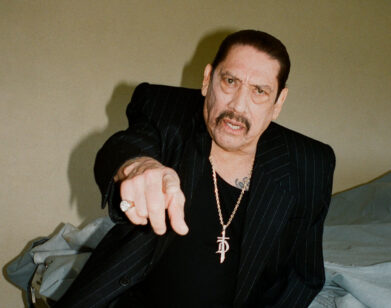New Again: Sam Taylor-Johnson

In New Again, we highlight a piece from Interview’s past that resonates with the present.
“A lot of people ask me if the next step is to make a feature film,” Sam Taylor-Johnson (then still Sam Taylor-Wood) told Interview in 1998. “I don’t count it out, but, at the same time, I like to work with a non-narrative base.”
Flash forward to 2013, and Taylor-Johnson already has one film behind her, 2009’s Nowhere Boy, and is set to direct the overwhelmingly popular erotic novel, Fifty Shades of Grey by author E.L. James. (Here’s hoping she casts her husband, 23-year-old Aaron Taylor-Johnson).
Before venturing into film, Taylor-Johnson had a successful run as an artist, with her work appearing in numerous exhibitions in the late ’90s, including the Venice Biennale and Hayward Gallery in London. To celebrate this Fifty Shades announcement, we decided to revisit the below October 1998 interview between 31-year-old Taylor-Wood and filmmaker(/Elton John’s spouse) David Furnish around the time her Work In Progress exhibit was on display at the Prada Foundation in Milan. —Lauren Lieb
The Spot Lighter
By David Furnish
Why has Sam Taylor-Wood become of the world’s most sought-after artists—so sought-after, in fact, that this fall alone her world can be seen both in London on view at the Tate Gallery beginning this month, and in Milan where she is mounting a show at the Prada Foundation in November? Because by working with raw human emotion Taylor-Wood creates pieces that go deep inside and grab us at our core.
DAVID FURNISH: The past year or two has been jam-packed for you, starting perhaps with the recognition you received during the last Venice Blennale and continuing to the present.
SAM TAYLOR-WOOD: And personally it’s been an intense period, too. I had my daughter, Angelica, a month before Venice, then I got married, and then just a few days after that I was diagnosed with cancer.
FURNISH: You underwent major surgery, and you’ve gone through a process of recovery.
WOOD: Yeah, and all through that your thoughts become very strange. After the operation, you have this total elation because you’ve survived and now you’ve got your whole life before you.
FURNISH: Since you work mostly within the mediums of film and video, it’s difficult to show your work pictorially. How would you describe it to someone unfamiliar with it?
WOOD: I’m interested in taking raw human emotions and then isolating them without any narrative structure. In order to achieve this, I try to break out of the narrative conventions that you’d see in a typical feature film. For example, if you were to see an argument in the cinema, you would see where that argument started because it came out of a progressive structure. I’m much more interested in showing the individual form of that argument—it’s basis and emotional content.
FURNISH: Can you explain this in relation to one of your works?
WOOD: I made this piece called Travesty of a Mockery, which features a man and a woman arguing. I filmed each of them with separate cameras, shooting across the same room at each other, and then projected them individually on opposite facing walls. It ends up looking like they are shouting across a room at each other. When you see this, you don’t understand why they’re fighting, but you understand instantly the feeling that’s going on between them. There’s a great moment when the woman throws a glass of milk into the face of the man. You can’t escape feeling like a participant.
FURNISH: By isolating human emotion like that, are you trying to make a larger social comment?
WOOD: I’m interested in looking at the minuscule details of something in order to recognize the grand scale. There’s a sense right now of people feeling disconnected from the world we live in, of feeling slightly out-of-harmony with their environment.
FURNISH: Did being apart of a certain generation in the art world affect the way you approach your art?
WOOD: I went to Goldsmith College of Art in London in the ’80s and there I made sculptures, but the objects had nothing to do with how I was thinking. I was making beautifully sanded wooden boxes! After I left college I went to work at the Royal Opera House in London, which became a real catalyst for me because it made me realize that I was interested in cinema and in the way life is thrust at you. So I started making films.
FURNISH: Was that because with film you could explore emotions that you couldn’t express in sculpture or photography?
WOOD: Yes. But it’s been important for me as well to make film in different formats in order to express different things. When I made Brontosaurus, about a man dancing naked in his bedroom, it was important that it have a home-movie film to it. I filmed him for half an hour, and after watching the footage I decided to slow things down because his movements were so bizarre.
FURNISH: It reminds me of those moments on news programs where they do slow-motion tributes—for example, Princess Diana hugging children and picking up flowers in slow motion. It’s a suspension of life and time—an act of mourning.
WOOD: Yes. I made Brontosaurus at just the time when quite a few people around me had died. Sometimes, I think, your work is a bit ahead of you without you realizing it.
FURNISH: What made you want to be an artist?
WOOD: I didn’t want a job. [laughs] Seriously, I wanted to be an artist because I saw that it meant endless possibilities. I came from a badly managed family background so art was a way or reinventing myself.
FURNISH: How did your experience at Goldsmith influence you?
WOOD: Well, all around me were these brilliant contemporaries who were making the most exciting artwork I had seen for a long time. That was inspiring, but as people became superstars while still at college the school became a very strange environment. It was sort of oppressive for a while.
FURNISH: How much of the artistic rejuvenation brought about by Goldsmith’s graduates and others had to do with the changes taking place in Britain at the time? Because Britain is a vastly different country from what it was 20 years ago.
WOOD: We were living in a time that was very unsupportive of the arts, and we were aware of that. And, very often, when you are handed things on a plate, you don’t work quite so hard for what you want. When you’re being starved of any possibility, you work much harder. That’s what happened here. People like Damien Hirst came out and put on their own exhibitions and forced their way into what seemed like quite a difficult world to enter.
FURNISH: Can you talk for a minute about the process you go through to make your art?
WOOD: It’s really simple: I have an idea and I make it. My work is made on lines similar to those of a film production. A lot of my work is kind of bureaucratic, endlessly phoning up people, trying to find the cameraman and the lighting man, because I am a total technology-phobe, quite helpless with equipment.
FURNISH: Your recent work for the Pet Shop Boys concert in London must have been a technological nightmare then.
WOOD: That turned out to be very difficult, but more for the reasons that had nothing to do with technology. The idea behind the film was that Neil Tennant and Chris Lowe would step in and out of this party during the performance of their concert. I wanted everyone to be sober at the beginning of the film and very drunk by the end. It was shot in real time and had to run exactly the same length as the concert—one hour and twenty minutes. But when I started filming I forgot that once everyone was drunk they would be completely uncontrollable. So there I was trying to direct 15 drunk people. Towards the end, nobody cared what I was saying. I ended up screaming until I lost my voice. Usually though, the filming’s done in a day and from there it’s all postproduction. The photographs are made in a similar way—having people stage an environment and directing them to make the photograph more effective, how I imagine it to be. A lot of people ask me if the next step is to make a feature film. I don’t count it out, but at the same time, I like to work with a non-narrative base.
FURNISH: You push emotion to the limit.
WOOD: Yeah, yeah.
THIS INTERVIEW ORIGINALLY RAN IN THE OCTOBER 1998 ISSUE OF INTERVIEW.
New Again runs every Wednesday. For more, click here.






